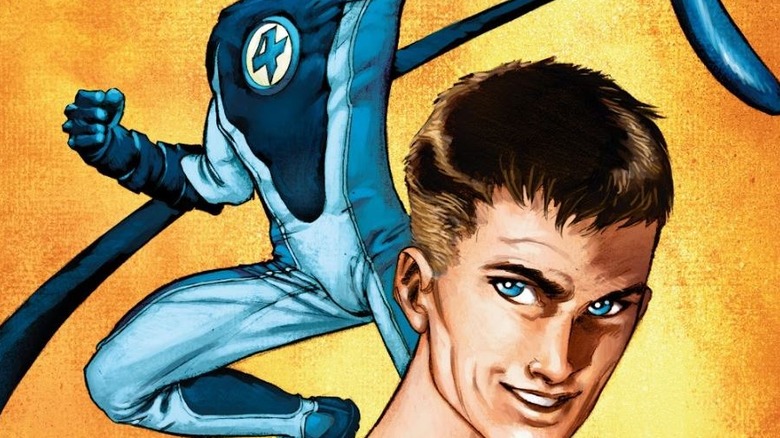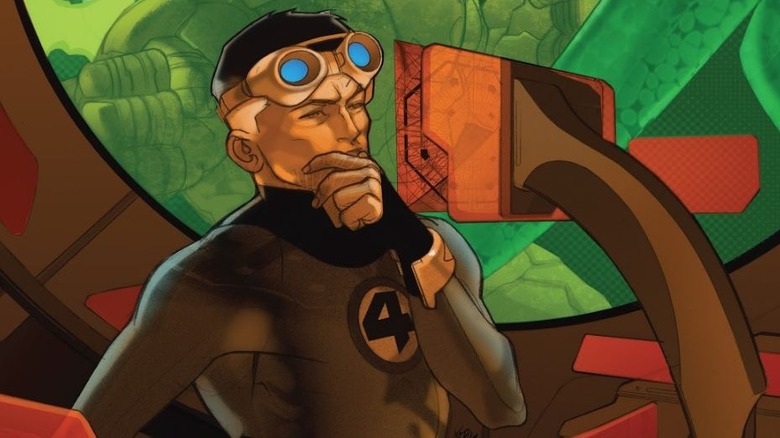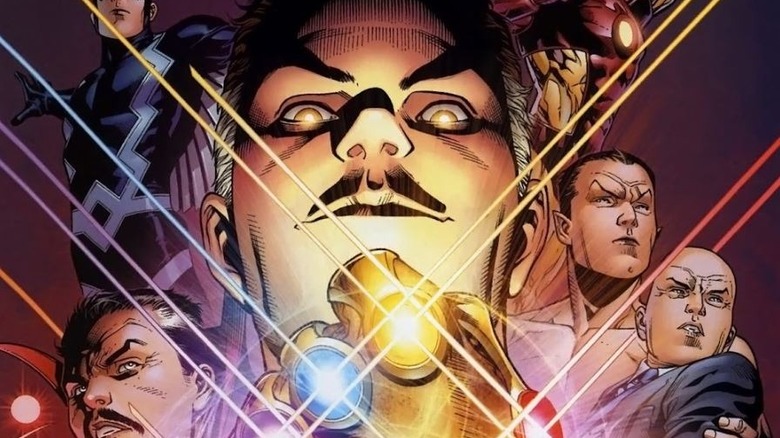The Untold Truth Of Marvel's Reed Richards
He is one of Marvel Comics' oldest characters, the patriarch of the first superhero family, and 12 degrees more intelligent than fan-favorite genius inventor Tony Stark. He is none other than Reed Richards, aptly known as Mister Fantastic. Sadly, when the Marvel Cinematic Universe took off through space and time, Reed Richards was completely absent due to a rival studio owning his movie rights. Even worse, a minor appearance in "Doctor Strange in the Multiverse of Madness" failed to signify the character's importance and quickly killed off the stretching superhero in a ridiculous spaghetti-themed farewell.
Finally, after multiple forgettable "Fantastic Four" movies — and one technically unreleased "Fantastic Four" film – Marvel is poised to give the iconic Reed Richards and the Fantastic Four a true introduction to the mainstream MCU. Fans have patiently awaited the superhero family's MCU arrival since Disney's acquisition of 20th Century Fox, which included the rights to the FF, back in 2019. Now with a 2025 release date, casting rumors have been swirling, with Adam Driver possibly landing the role of Reed Richards instead of John Krasinski, who portrayed the character in "Multiverse of Madness."
Regardless of who plays the leader in the upcoming "Fantastic Four" — maybe it'll be Driver, and maybe it won't be — it is time for fans to prepare for one of Marvel's longest-stretching characters to take his place in the official MCU timeline. The rubber man has been one of the most prominent, dynamic, and sometimes problematic characters in Marvel Comics. His inclusion, and that of the adventurous foursome, could have a significant impact on the cinematic mega-franchise moving forward. Keep reading to discover how important Reed Richards is to Marvel, how he is one of the most complex characters in the company's roster, and how he could be the biggest villain of them all.
His powers were stolen from another superhero
The Fantastic Four maintain a prominent placement in comic book history. One version of the legend told by Stan Lee, who was not exactly known for autobiographical consistency, is that the celebrated creator was ready to walk away from Marvel and comic books but was encouraged by his wife to try his hand at one more title. Wanting to write a more reality-based character-driven superhero book, Lee got to work on "Fantastic Four" #1, released in 1961. Co-creator and artist Jack Kirby also laid claim to inventing the FF, and much of his previous work indicates that may be true. However, it is well-documented that Lee and Kirby collaborated, to some degree, on all of their co-authored works.
Despite the debate, the themes and success of "Fantastic Four" helped Marvel Comics find its footing, leading to new characters and titles such as "The Uncanny X-Men" and "The Amazing Spider-Man" that made the publishing company what it is today. Still, while it seemed to be groundbreaking for the time, much of what made "Fantastic Four" popular was not new. Marvel was attempting to create a superhero team to capitalize on the rising popularity of "Justice League" from the rival company that would eventually be known as DC Comics. Meanwhile, the characters' powers were pretty much borrowed from other books. The Human Torch was a new version of a character previously introduced in "Marvel Comics" #1 in 1939. More surprisingly, Lee admits that Mister Fantastic's powers are lifted from the competitors. "I liked Plastic Man," the writer stated in a 1968 interview. "That's a great power, and nobody is using it, so I gave Reed Richards' Plastic Man's power."
He was once replaced by Stan Lee
Stan Lee and Jack Kirby may have created the Fantastic Four, and by extension created one of the biggest money-making popular culture franchises of all time, but the story of how it came to be is different depending on who you ask. Probably the most interesting origin stories for the Fantastic Four's success take place inside of a comic book. "What If?" #11, published in 1978, boldly asks the question: "What if the Fantastic Four Were the Original Marvel Bullpen?" The story reimagines a foursome of Marvel employees from the early days of the company as the famous superhero group that helped build the empire.
The story starts with a mysterious box arriving at Marvel headquarters and shooting out cosmic rays, mutating the small bullpen of the early 1960s. Included in the alternate reality FF are former office manager "Fabulous" Flo Steinberg as Invisible Woman and regular inker-slash-writer Sol Brodsky as the Human Torch. Most notably, Jack Kirby, known for being gruff but soft on the inside, fittingly fills in for The Thing. Meanwhile, Reed Richards is replaced by long-time Marvel leader and editor-in-chief Stan Lee. As the foursome uncover where the box came from and stop the nefarious Skrulls, they spend their days publishing comics about their exploits as the Fantastic Four. And while it is completely imaginary, it is the most entertaining version of how Lee and Kirby cooked up the famous superhero team.
He was fighting aliens before he had superpowers
It is hard to imagine Reed Richards as anything but a nerd before the fateful collision with cosmic rays that gave him the powers of elasticity. However, throughout the many decades of comics publishing, many of Reed's exploits pre-"Fantastic Four" #1 have been revealed. Unsurprisingly, he had a few run-ins with his former classmate and longtime arch nemesis Doctor Doom. Originally, Reed, alongside best friend Ben Grimm, fought in World War II, although this has since been removed from the character's history to adjust for the sliding timescale of Marvel comics. Still, the most surprising accomplishment of Reed Richards before his fateful flight to space involves fighting off an alien invasion.
In "Fantastic Four" #271, Reed struggles to gain his memory back after a time of imprisonment in the Negative Zone. Thankfully, pieces begin coming back to him, specifically a short period before he became Mister Fantastic. On a date with Susan Storm, a much younger Reed was present for the arrival of the dangerous alien known as Gormuu. The monstrous beast explains his intentions of conquering Earth and begins growing larger and larger. Thankfully, the always clever Reed discovers the device that causes Gormuu to grow even more and uses it to make the invader too large to maintain himself. Using intelligence to defeat a threat is a go-to move for Mister Fantastic, and the story proves that Reed doesn't need his superpowers to protect the Earth.
He is autistic
Comic books have been at the forefront of representation more often than they get credit for. When the X-Men arrived in Marvel in 1963, the theme of unfairly maligned outsiders seeking equal treatment was a direct commentary against discrimination that was prevalent in the United States at the time. Equally, Marvel made people of color prominent characters long before many other media platforms caught up. It has long been the goal of Marvel Comics to assure all their young readers can find a character in the roster that can represent them. And when it comes to living with autism, Reed Richards is a glowing hero.
It was long speculated that Mister Fantastic landed somewhere on the spectrum. However, in the early '60s when the Fantastic Four arrived in popular culture, autism was hardly on anyone's radar. Thankfully, in the many years that have passed, it has officially become canon that Reed Richards is autistic. The first to make this acknowledgement was Grant Morrison in his 2001 miniseries "Fantastic Four: 1234," and Reed's status on the spectrum gets mentioned again in "Fantastic Four: Season One" from 2012.
He can do more than stretch
There is no shortage of characters who can flex and stretch like Mister Fantastic, including Plastic Man, Ms. Marvel, and Elastigirl. However, the patriarch of the Fantastic Four separates himself from the pack with a unique assortment of abilities beyond super reach. The most obvious attribute that makes Reed Richards different from his competitors is his incredible intellect, which adds another layer to his crime-fighting repertoire. Yet, the list of skills Mister Fantastic has stretches farther than his arms.
Reed has been known to use his stretching talents in an assortment of clever ways, including lock picking and twisting himself to create a fan that generates incredible wind power. Some of the more interesting ways uses his superpower involve him becoming a bouncing ball or floatation device to suit certain circumstances. Still, even when Reed loses his powers — as superheroes are known to do from time to time — he has a few more cards up his long sleeves. Surprisingly, he is one of the top Judo experts on the planet — a skill that he has perfected with his unique skill set for optimal body-striking hits. Additionally, Reed is a master of hypnosis, which he utilizes in "Fantastic Four" #2 to trick Skrull invaders into believing they are average Earth cows.
He hides his true self
Long before the MCU made it commonplace for superheroes to pop up in each other's movies, one of the closest things fans had to a crossover was Wolverine's short cameo in 2005's "Fantastic Four," even though Hugh Jackman did not appear on set for the Easter egg and his partial likeness was inserted via computer graphics. However, Reed's ability to transform his face brings up a serious question: Does anybody really know what Mister Fantastic looks like?
A significant amount of time has passed since Reed Richards led his fearless foursome into space to be mutated by cosmic rays. Yet even then, Mister Fantastic was showing signs of aging, sporting a recognizable gray streak through his hair. With time passed, and the extreme amount of work hours and stress that Reed tends to put in, the signs of aging should be showing on his face. However, the ability to rubber band his entire body could easily negate any wrinkles showing up on his skin. This theory was legitimized in "Fantastic Four: Life Story" #4 when the FF leader wakes up from an extended rest. Readers can clearly see the years have taken a toll on the hero, yet it only takes ol' Reed a few seconds to transform his face back into pristine condition.
The smartest man alive
For decades, Reed's status as the premiere intellect in the world — perhaps in the galaxy — made up a significant part of Mister Fantastic's identity. For most of his literary lifetime, it was bankable that Reed would be depended upon to solve the biggest questions facing the Marvel superhero community. However, over the years, and especially more recently, Mister Fantastic has been dethroned from his placement as the top Einstein in the universe.
The first person to surpass the FF leader in brain power is his own daughter, Valeria Richards. Reed insists on multiple occasions that his spawn, even when she's only 3 years old, is his intellectual superior. Meanwhile, Reed's absence from the MCU slowly turned public perception of the smartest Marvel character to big brains such as Tony Stark and Shuri. Canonically, at least as far as the comics universe goes, Mister Fantastic and the geniuses of the world have been shocked at the brilliance of another young mind – Moon Girl. Accompanied by her best friend Devil Dinosaur, Moon Girl has outsmarted the best Marvel has to offer, even completing a seemingly impossible intelligence quiz in mere seconds. With his daughter and Moon Girl running away in the race, it could still be argued that Reed is the smartest adult male in the universe. Stick that in your pipe and smoke it, Tony.
The Solve Everything plan
As the world's foremost intelligent mind, Reed Richards has created some astounding inventions: a portal that can travel to any dimension, a passage to the Negative Zone; he even found a way to safely visit the afterlife and bring people back from the dead. Still, Mister Fantastic's greatest accomplishment is arguably less of an invention and more of a strategy — the "Solve Everything" plan.
In the pages of "Fantastic Four" #551, the team is made aware of a possible future where Reed's ultimate project is enacted and successful. As the name suggests, the "Solve Everything" plan fixes the world of all its problems, or as Richards puts it, "End hunger, poverty, disease, and war. Increase freedom. Maximum potential, both individually and collectively. Create opportunities to challenge and enrich the human spirit." Of course, even in this perfect future, the always-jealous Doctor Doom is enraged with jealousy. The villain travels back to modern times to stop Reed from launching the "Solve Everything" plan so that he can save the world instead. Thankfully, the FF finds the future Doom an alternate Earth destroyed by the Hulk that he can go and save.
There are many evil versions of Reed Richards
Considering the countless number of times that the Fantastic Four have saved the world, most fans would expect the group to act equally heroic in every dimension across all realities. Sadly, that is not the case — especially when it comes to Reed Richards. Conversely, there are far more evil versions of Mister Fantastic in the Marvel multiverse than good versions. The most notable evil Reed comes from the Ultimate Universe, which is also the original home dimension of Miles Morales. Known as The Maker, this dark Mister Fantastic starts as a hero but transitions into a tortured soul, mostly due to being rejected by Sue Storm. Becoming one of the most nefarious villains in the universe, The Maker eventually becomes a thorn in the side of the Earth-616 heroes.
Still, there are much scarier versions of Reed Richards sprawled throughout the Marvel multiverse. There is one version who has a mental breakdown and deliberately infects his FF teammates with a zombie virus. Meanwhile, another transforms into a Hulk-like beast known as Brute and becomes president of the United States. The Dark Raider is a version of Reed who lost his teammates, along with the rest of his planet, in a battle with Galactus and spends the rest of his life hunting and killing his multiverse counterparts. And if that wasn't enough, there is the Interdimensional Council of Reeds made up of versions of Mister Fantastic but with far fewer morals.
The 616 Reed Richards may be the worst
Given that so many versions of Reed Richards across the multiverse have turned to the dark side, it is safe to assume that the mainstream Earth-616 version of Reed Richards often rides on the cusp of becoming evil himself. During his long literary history, there have been many times when Reed's inventions and ideas push the limits of morality. And there have been many occasions where his behaviors have pushed away his super family, including Susan Richards (née Storm).
Though he often sees the light before going too far into the darkness, Reed has done some terrible things in the past. During the "Civil War" crossover event, Reed is responsible for creating a clone of Thor that attacks some of his closest friends. Mister Fantastic is also a primary member of The Illuminati – a collection of influential superheroes who attempt to secretly control events throughout the planet. Unfortunately, The Illuminati make some immoral decisions and plenty of mistakes, including banishing The Hulk from Earth.
He is an even worse friend
Deep down Reed Richards is a family man who travels to the darkest corners of the galaxy for his children and teammates. Unfortunately, Mister Fantastic is also a highly complex superhero who often puts the burdens of the world on his flexible shoulders. Sadly, Reed is known to put work first and leave his closest loved ones feeling ignored and abandoned. Worse, the man who has saved the world countless times is also guilty of mistreating his family and friends.
Some of the most harrowing examples of Mister Fantastic's misbehavior towards his family include manipulating his son, Franklin Richards, and often mistreating his wife, Sue. If that didn't make the FF patriarch a dirtbag, he doesn't treat his best friend any better. Reed has always felt guilty about causing the accident that mutated Ben Grimm into the monster known as The Thing. Promising for decades to find a way to cure his teammate, helping Ben is often a background narrative of "FF" comics. Sadly, throughout the years Reed has proven many times that he is capable of helping The Thing regain his human form. However, with most of the cures only lasting for a limited amount of time, it is suspected — though not proven — that Reed avoids helping his friend for fear of losing the strongest member of his superhero squad.
He's the only Fantastic Four member without his own comic
"Fantastic Four" is credited as the launching point for the Marvel Universe as audiences recognize it today. The timeline for the comic book universe uses FF's accident with cosmic rays in space as the milestone event that kickstarts the entire modern age of the Marvel Universe. With over 60 years of comic book content, the Fantastic Four are some of the most important characters for the company.
The Thing, specifically, was utilized as one of the faces of the company alongside Spider-Man and The Hulk for many decades. As such, the big orange rock monster has championed many of his own titles as well as the long-running "Marvel Two-in-One" series. Johnny Storm filled the shoes of his predecessor Jim Hammond, who starred as Human Torch in the '40s, with his own "The Human Torch" comic book in 1974. And although it took a while, Sue Richards headlined her own "Invisible Woman" title in 2019. However, despite being the undisputed leader of the fan-favorite team, Mister Fantastic has still never had his own self-titled series.












